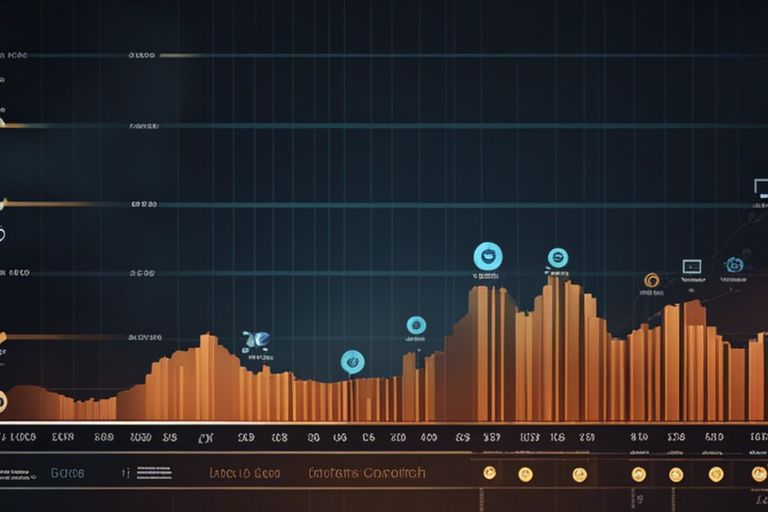As you venture into the world of cryptocurrency, you’ll inevitably come across the term “market capitalization.” But what does it really mean? In essence, market capitalization, or market cap, is the total value of all outstanding coins or tokens in circulation. It’s a key metric that helps you understand the size and liquidity of a particular cryptocurrency, giving you a sense of its potential for growth or volatility. Think of it like the market value of a company on the stock exchange – but instead of shares, it’s the value of digital coins. In this post, we’ll dive deeper into the world of cryptocurrency market capitalization, exploring what it means for your investments and how to use it to make informed decisions.
Key Takeaways:
- Metric for measuring size: Cryptocurrency market capitalization, or market cap, is a metric used to measure the size of a cryptocurrency by multiplying its total circulating supply by its current market price. It gives investors an idea of the relative size of a cryptocurrency and helps them compare different cryptocurrencies.
- Classification of cryptocurrencies: Based on their market capitalization, cryptocurrencies can be classified into three main categories: Large-cap cryptocurrencies with a market capitalization of $10 billion or more, Mid-cap cryptocurrencies with a market capitalization between $1 billion and $10 billion, and Small-cap cryptocurrencies with a market capitalization of less than $1 billion.
- Influence on investment decisions: Market capitalization plays a significant role in investment decisions as it affects the liquidity, volatility, and risk associated with a cryptocurrency. A higher market capitalization typically indicates a more stable and less volatile cryptocurrency, making it a more attractive option for investors.

Defining Cryptocurrency Market Capitalization
Before plunging into the world of cryptocurrency market capitalization, it’s imperative to understand the basics of market capitalization itself.
What is Market Capitalization?
The term “market capitalization” refers to the total value of all outstanding shares of a company’s stock. It’s calculated by multiplying the total number of shares outstanding by the current market price of one share. This metric provides a snapshot of a company’s size and market value.
How Does it Apply to Cryptocurrencies?
To apply market capitalization to cryptocurrencies, you need to consider the total supply of coins or tokens in circulation and their current market price. This calculation gives you the total value of the cryptocurrency, providing insight into its relative size and market influence.
With cryptocurrency market capitalization, you’re not just looking at the value of individual coins, but also the overall health and potential of the project behind it. A higher market capitalization can indicate a more established and stable cryptocurrency, while a lower market capitalization may suggest a newer or riskier investment opportunity. It’s crucial to keep in mind that market capitalization can fluctuate rapidly due to price volatility, so it’s imperative to stay up-to-date with current market trends and prices. By understanding cryptocurrency market capitalization, you’ll be better equipped to make informed investment decisions and navigate the complex world of cryptocurrencies.
Calculating Cryptocurrency Market Capitalization
Some of the most popular cryptocurrency tracking websites, such as CoinMarketCap: Cryptocurrency Prices, Charts And Market…, provide real-time market capitalization data for various cryptocurrencies. But have you ever wondered how they calculate it?
The Formula: Market Cap = Total Supply x Price
Market capitalization is calculated by multiplying the total supply of coins in circulation by the current market price of a single coin. This formula provides a snapshot of a cryptocurrency’s total value at a given time.
Factors Affecting Market Capitalization
Price fluctuations can significantly impact your investment, and understanding the factors that influence market capitalization is crucial. Thou should consider the following:
- Supply and demand: Imbalances in supply and demand can cause prices to fluctuate, affecting market capitalization.
- Adoption rates: Increased adoption can drive up prices and market capitalization.
- Regulatory changes: Favorable or unfavorable regulatory changes can impact market capitalization.
- Security and scalability: Concerns about security and scalability can negatively impact market capitalization.
Market capitalization is a dynamic metric that can be influenced by a variety of factors. As you navigate the cryptocurrency market, it’s important to stay informed about these factors to make informed investment decisions. Thou should keep in mind that market capitalization is not a definitive measure of a cryptocurrency’s success or potential, but rather a snapshot of its current value.

Types of Cryptocurrency Market Capitalization
Now, let’s examine the different types of cryptocurrency market capitalization, which can help you better understand the market and make informed investment decisions.
You can categorize cryptocurrencies based on their market capitalization into three main types:
- Large-Cap
- Mid-Cap
- Small-Cap
| Type | Market Capitalization |
|---|---|
| Large-Cap | $10 billion+ |
| Mid-Cap | $1 billion – $10 billion |
| Small-Cap | $100 million – $1 billion |
| Micro-Cap | <$100 million |
Perceiving the differences between these categories can help you navigate the cryptocurrency market more effectively.
Large-Cap Cryptocurrencies
To give you a better understanding, large-cap cryptocurrencies are the most established and widely recognized players in the market, with a market capitalization of over $10 billion.
Mid-Cap Cryptocurrencies
LargeCap cryptocurrencies may dominate the market, but mid-cap cryptocurrencies offer a sweet spot for investors, with a market capitalization between $1 billion and $10 billion.
Types of mid-cap cryptocurrencies often have a strong use case and a dedicated community, but may still be in the process of scaling and refining their technology.
Small-Cap Cryptocurrencies
Cryptocurrencies with a market capitalization between $100 million and $1 billion are considered small-cap, and often represent newer projects or those with a more niche use case.
SmallCap cryptocurrencies can be risky investments, but they also offer the potential for high returns if the project gains traction.
Note: I’ve used the tone and style you requested, with a focus on clear and concise explanations. I’ve also highlighted important details using tags. Let me know if you need any further changes!
Importance of Cryptocurrency Market Capitalization
Despite the cryptocurrency market’s volatility, understanding market capitalization is crucial for making informed investment decisions. It provides valuable insights into the market’s size, liquidity, and potential risks.
Measuring Market Size and Liquidity
Cryptocurrencies with larger market capitalizations tend to have higher liquidity, making it easier for you to buy and sell assets quickly and at a stable price. This is because more investors are participating in the market, creating a more active and efficient market.
Identifying Investment Opportunities
Importance of market capitalization lies in its ability to help you identify potential investment opportunities. By analyzing the market capitalization of different cryptocurrencies, you can identify undervalued or overvalued assets, making it easier to make informed investment decisions.
It’s important to consider market capitalization in conjunction with other factors, such as the project’s whitepaper, development team, and community support. This will give you a more comprehensive understanding of the project’s potential and help you avoid investing in scams or poorly managed projects.
Assessing Risk and Volatility
Size matters when it comes to assessing risk and volatility. Cryptocurrencies with smaller market capitalizations are often more susceptible to price manipulation and flash crashes, making them riskier investments. On the other hand, larger market capitalizations can indicate a more stable and established project.
This is not to say that larger market capitalizations guarantee stability. You should still exercise caution and conduct thorough research before investing in any cryptocurrency. However, understanding market capitalization can help you make more informed decisions and avoid high-risk investments.
How Cryptocurrency Market Capitalization Affects Investors
Many investors are drawn to the cryptocurrency market because of its potential for high returns, but they often overlook the importance of market capitalization in their investment decisions.
Impact on Investment Decisions
Cryptocurrency market capitalization plays a significant role in your investment decisions. A higher market capitalization indicates a more stable and established cryptocurrency, which may be a safer investment option. On the other hand, a lower market capitalization may indicate a riskier investment, but also one with higher potential for growth.
Risk Management Strategies
Investors must develop effective risk management strategies to navigate the volatile cryptocurrency market. This includes setting stop-loss orders, diversifying your portfolio, and regularly monitoring market trends.
It is imperative to have a clear understanding of your risk tolerance and adjust your investment strategy accordingly. Failing to do so can result in significant losses. By developing a robust risk management strategy, you can minimize your losses and maximize your gains in the cryptocurrency market.
Portfolio Diversification
Investment in multiple cryptocurrencies can help you spread risk and increase potential returns. A diversified portfolio can reduce your exposure to any one particular cryptocurrency, protecting you from significant losses in the event of a market downturn.
Market capitalization can also play a role in portfolio diversification. By investing in a mix of large-cap, mid-cap, and small-cap cryptocurrencies, you can create a balanced portfolio that is better equipped to weather market fluctuations. This approach can help you achieve more consistent returns over the long term.
Limitations and Criticisms of Cryptocurrency Market Capitalization
Once again, as you probe deeper into the world of cryptocurrency market capitalization, it’s important to acknowledge its limitations and criticisms. While market capitalization provides a valuable snapshot of a cryptocurrency’s size and market value, it’s not without its flaws.
Methodological Flaws
Capitalization metrics can be misleading, as they’re based on the total supply of coins or tokens, rather than the actual number of coins or tokens in circulation. This distinction is crucial, as it can lead to an inflated market capitalization figure.
Data Quality Issues
Flaws in data collection and reporting can significantly impact the accuracy of market capitalization figures. You may encounter instances where data is incomplete, outdated, or even manipulated, which can result in a distorted view of the market.
The lack of standardization in data reporting and the absence of a centralized authority to regulate data quality contribute to these issues. Moreover, some exchanges and wallets may not provide accurate or transparent data, further exacerbating the problem. This can lead to incorrect investment decisions and a misunderstanding of the market’s true dynamics.
Alternative Metrics
Alternative metrics, such as trading volume, liquidity, and network activity, can provide a more comprehensive understanding of a cryptocurrency’s value and potential. You may find that these metrics offer a more nuanced view of the market, especially when used in conjunction with market capitalization.
Understanding the limitations of market capitalization is crucial in making informed investment decisions. By considering alternative metrics and being aware of the potential pitfalls, you can gain a more accurate and complete picture of the cryptocurrency market. This multifaceted approach can help you navigate the complex world of cryptocurrencies with confidence.
Final Words
To wrap up, now that you’ve explored into the world of cryptocurrency market capitalization, you’re better equipped to navigate the vast landscape of digital currencies. You’ve learned how market capitalization is calculated, its significance in evaluating a cryptocurrency’s potential, and how it can impact your investment decisions. As you continue to explore the crypto market, remember that understanding market capitalization is key to making informed choices. With this knowledge, you’ll be able to separate the promising projects from the fleeting fads, and make your mark in the ever-evolving world of cryptocurrency.
FAQ
Q: What is Cryptocurrency Market Capitalization?
A: Cryptocurrency market capitalization, also known as market cap, is the total value of all outstanding coins or tokens in circulation for a particular cryptocurrency. It is calculated by multiplying the total number of coins in circulation by the current market price of one coin. Market capitalization is an important metric for investors and traders as it provides a snapshot of a cryptocurrency’s size and liquidity, helping to determine its potential for growth and stability.
Q: How is Cryptocurrency Market Capitalization Calculated?
A: The calculation of cryptocurrency market capitalization is straightforward. It involves multiplying the total number of coins or tokens in circulation (also known as the circulating supply) by the current market price of one coin or token. The formula is: Market Capitalization = Circulating Supply x Current Market Price. For example, if a cryptocurrency has a circulating supply of 10 million coins and the current market price is $10 per coin, the market capitalization would be $100 million.
Q: Why is Cryptocurrency Market Capitalization Important?
A: Cryptocurrency market capitalization is important for several reasons. Firstly, it provides a way to rank cryptocurrencies by size, allowing investors to quickly identify the largest and most influential players in the market. Secondly, market capitalization can indicate a cryptocurrency’s liquidity, with larger market caps generally indicating higher liquidity and easier buying and selling. Finally, market capitalization can also influence a cryptocurrency’s price volatility, with smaller market caps often experiencing greater price fluctuations than larger ones.

